My system:
M/B: Gigabyte GA-7VRXP Rev 2.0 (VIA KT333)
CPU: AMD Athlon XP Palomino 2000+
RAM: 2 x 512MB DDR333
HDD: Seagate 120GB/Western Digital 80GB
PSU: Codegen 350W (running at 230V)
Graphics Card: Asus GeForce4 V8460 Ultra Deluxe
Hi everybody! I hope I can get some help from someone that knows things better than I do at the moment.
1. History in detail:
Ok, here's the story, so far:
I did a fresh install of WinXP SP2 some months ago, and ghosted my old W2K to my second harddrive. WinXP gradually got more and more instable. First program errors, then sudden reboots and finally really big problems to even boot windows (sudden reboot -> windows start up half way -> BSOD for a ½ second -> sudden reboot... over and over again). The reboots seemed to be more frequent when it was hot in my room = warmer computer, but not under stress.
Thought it was a problem with WinXP so I went back to my all time stable W2K by choosing to boot from the second harddrive at start up. This worked fine for a couple of days but suddenly I was getting reboots on the second drive too. Then I realized it was a hardware problem. In the end I couldn't boot in to neither of my harddrives.
First I thought it was the PSU (a Codegen 350W that came with the case. A no name that has worked without any problems for me) since I had similar problem symptoms a year ago when my Antec TruePower 550W started to misbehave (after only 2 years of use *see footnote). I tried with another PSU, no difference.
Then I did some memtest, no problems there either. Tried with just one RAM-stick in each of the 3 slots but couldn't boot into windows. Not a RAM problem.
Checked my harddrives with programs found on the "Ultimate Boot CD". No errors.
So now its either the mobo, CPU or the graphics card. I had no second replacements for those parts which made it a bit more difficult to get to the core of the problem (I don't even know how to check a graphics card for errors).
I disconnected both harddrives and run CPU Burn-In and Mersenne Prime Test (from the Ultimate Boot CD).
Suddenly I was getting errors, hang-ups and reboots. The temperature of the CPU, reported in BIOS, was still ok.
Thought I've found the problem. Ran another memtest and memtest+, but now I got a lot of errors (in pass 7 I think). Don't know how much the CPU effects memtests, but I guess it has it share.
I now took the computer apart and examined all the parts. The RAM and the CPU looked as new to the eye. However the mobo was a bit miscolored/darkened (from heat I suppose) on its backside just where the VRM mosfets (or what those little black "boxes" are called?) are located. On the frontside the soldering to these VRM mosfets was miscolored too.
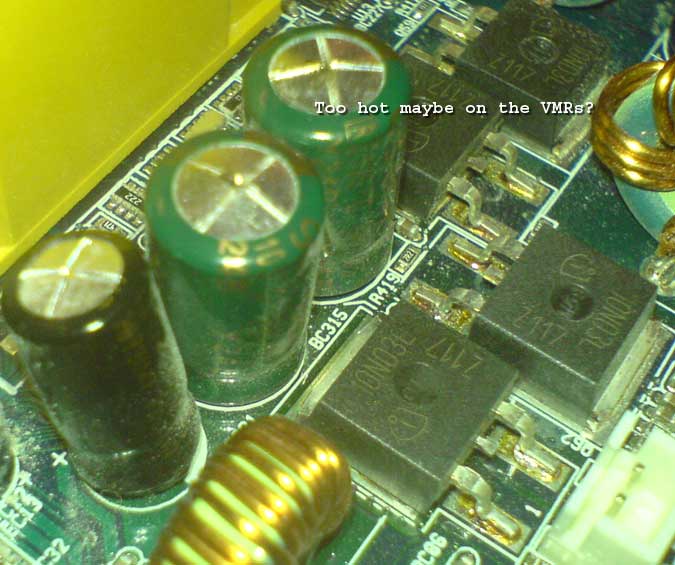
The 5 caps closest to the VRM and the CPU all had bulged tops and one was bent at the bottom (2 x Choyo 3300uF 6,3V | 2 x GSC 1200uF 6,3V | 1 x G-Luxon 1000uF 6,3V). At the time I didn't really know that bulged caps was a problem...
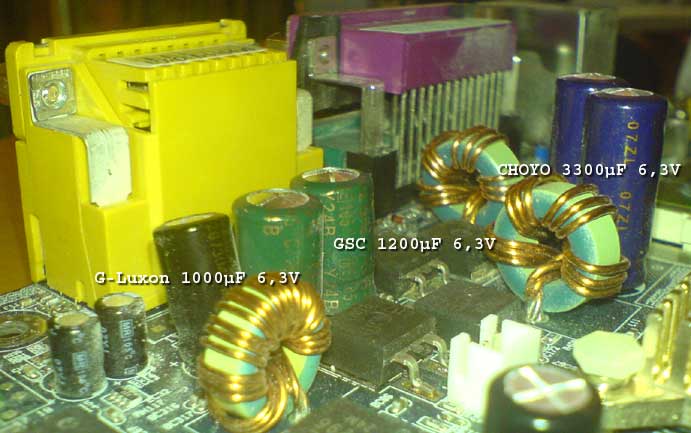
I then reassembled the computer without harddrives and ran a new go with the CPU Burn-In test. It ran for hours without any errors. Earlier the errors would come as soon as 5-15 minutes. I hooked up the harddrive with W2K and was able to boot into windows now! But after 10 minutes or so the computer froze -> reset button. Ran a new CPU-test and was getting the errors again and sudden reboots, sometimes with no picture when it rebooted. If I didn't get a picture I had to shut it down and wait for a minute or two. Some thermal problem I guess.
Finally the computer just shut off without a reboot. Tried again later to boot, it was on for maybe a minute and then again just shut down completely.
At the same time I stumbled upon this whole world of bad caps when googling around for solving the problem. A big "thank you" to all of you!!
I decided to give recapping a chance. I bought replacements for the 5 caps mentioned before (for a start) from ELFA located here in Sweden. I chose Sanyo MV-WX that was recommend by CapacitorLab as a suitable caps for mobos.
I consider myself rather handy, even if it was some time since I last did soldering work. Even if the mobo wouldn't come to life again I could live with that. Since it's from the 2002 maybe it would be a good time to upgrade the entire computer anyway...
I got going with a new 60W soldering iron and struggled for quite a while, but couldn't get the solder to melt. So the next day I gave it a go with a 100W iron (with a rather big chisel tip, too big and clumsy IMO) and had better luck. But still it was a bit tricky to get the caps out at first, with the too large tip. (Could have used some practice too, I guess ;P but no old mobo to practice on though.) Soldered on the new caps and checked mobo for any possible damage.
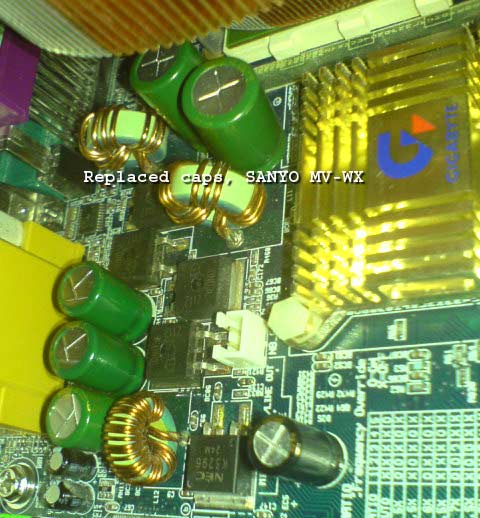
I put the mobo back in the case and connected the PSU to it. I didn't install any RAM or the CPU or anything else, just case fans connected straight to the PSU. I was afraid that something might fry. I don't know if thats a Big NO-NO to just connect the PSU to the mobo without connecting anything else?
Nothing happened. Just the yellow little RAM-light on the mobo (that is lit whether or not there are RAM installed, don't really understand the point of that, maybe someone does?). The fans didn't even nudge.
So I installed CPU + heatsink, 1 RAM-stick and the graphics card to see if the mobo needed a CPU to boot. Nothing again! Just that yellow RAM-light.
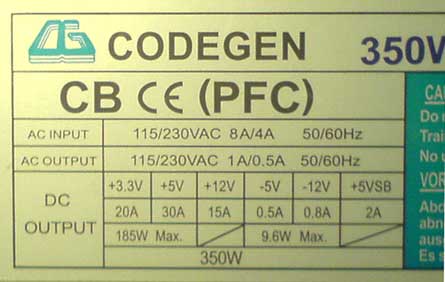
Then it hitted me that the PSU fan didn't spin either. Disconnected the PSU from mobo and tried to "hotwire" it with a cord (green cord to black ground). I have never hotwired a PSU before so I don't know if it should work on my PSU. Did a reading of the 12V & 5V Molex with a multimeter. Zero volt, as I expected.
But still it was able to produce some power, since the yellow light when connected to mobo.
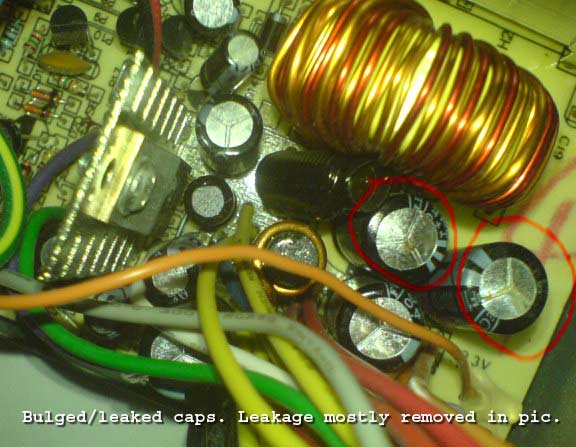
Opened up the PSU and found 2 caps bulging/leaking at the top. The brand of all the caps inside are "HEC", except for the 2 huge 200V that are "Jun Fu". The leaking ones are both 1000uF 10V what I can see. One is taller and the shorter one is labeled FHA (like some other caps in the PSU).
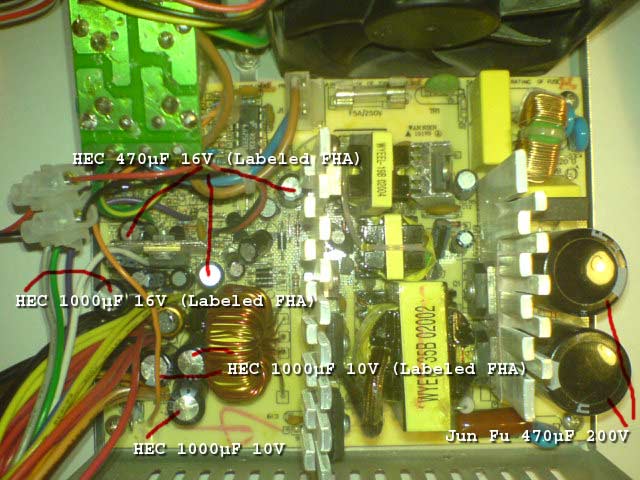
The fuse seems intact what I can see. Don't really know how a broken looks though.
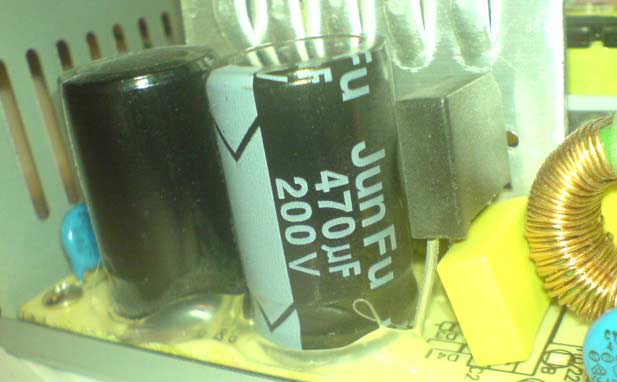
2. PSU questions (Running at 230V!):
I know there is a shock hazard involved with PSUs and recapping them. But I have not found any good guide for that job. I would like to know how the procedure looks like. What the DOs and DON'Ts are. What the dangers are etc etc. I mostly want to learn. Repairing the PSU is not the main target here.
Do you think its the caps that are the problem with the PSU. Or is it shorted some how beyond repair?
Or is the green wire hotwire trick not working and the PSU is actually still working?
What kind of caps should I use? Same kind as the ones I used for the mobo? The caps I can get hold of have all kind of different typ names (MV-WX, UAX, RJH, MV-AX and so on...) and all this is totaly greek for me. Here is a link to the different types of caps I can get my hands on. It's in Swedish so please bear with me =)
http://www.elfa.se -> in left column, choose "Kondensatorer" -> choose "Elektrolytkondensatorer, hålmonterade"
Hope you do get something sense out of it =) Btw, "kondensator" means capacitor.
What caps should i change? Should i change the small 470uF 16V, they all look ok. How about the huge 470uF 200V?
Does the "FHA" that is labeled on some of the 1000uF stand for something important?
If i do a proper recap, is there still a risk that I fry a new mobo, CPU, RAM etc etc with the PSU?
Motherboard questions:
Do you think its a case of bad recapping or could the problem be the VRM?
It's possible that there could have been to much heat from the solder iron during the recapping, but I couldn't see any visible signs of that on the mobo. Is it possible that the heat could have destroyed one of the new caps? I know that I did put a little too much heat to one of them IMO, but then I don't have a clue what "too much heat" actually means.
Is this mobo now a PSU killer? What can a mobo do to a PSU?
Is it dangerous to connect a PSU to a mobo without CPU or RAM? What can happen?
A big THANK YOU to everyone who takes the time to answer!
__________________________________________
* I recently sent my Antec TruePower 550W for RMA before the 3-year warranty ran out on me. The PSU has been in its box for the last year since I never took the time to make a complaint about it. Today I got a completely new PSU from the RMA office, wrapped in plastic and everything. That I didn't expect! But as I've learned now I guess this one's caps are going to give problems later on as well...
But as I've learned now I guess this one's caps are going to give problems later on as well...
M/B: Gigabyte GA-7VRXP Rev 2.0 (VIA KT333)
CPU: AMD Athlon XP Palomino 2000+
RAM: 2 x 512MB DDR333
HDD: Seagate 120GB/Western Digital 80GB
PSU: Codegen 350W (running at 230V)
Graphics Card: Asus GeForce4 V8460 Ultra Deluxe
Hi everybody! I hope I can get some help from someone that knows things better than I do at the moment.
1. History in detail:
Ok, here's the story, so far:
I did a fresh install of WinXP SP2 some months ago, and ghosted my old W2K to my second harddrive. WinXP gradually got more and more instable. First program errors, then sudden reboots and finally really big problems to even boot windows (sudden reboot -> windows start up half way -> BSOD for a ½ second -> sudden reboot... over and over again). The reboots seemed to be more frequent when it was hot in my room = warmer computer, but not under stress.
Thought it was a problem with WinXP so I went back to my all time stable W2K by choosing to boot from the second harddrive at start up. This worked fine for a couple of days but suddenly I was getting reboots on the second drive too. Then I realized it was a hardware problem. In the end I couldn't boot in to neither of my harddrives.
First I thought it was the PSU (a Codegen 350W that came with the case. A no name that has worked without any problems for me) since I had similar problem symptoms a year ago when my Antec TruePower 550W started to misbehave (after only 2 years of use *see footnote). I tried with another PSU, no difference.
Then I did some memtest, no problems there either. Tried with just one RAM-stick in each of the 3 slots but couldn't boot into windows. Not a RAM problem.
Checked my harddrives with programs found on the "Ultimate Boot CD". No errors.
So now its either the mobo, CPU or the graphics card. I had no second replacements for those parts which made it a bit more difficult to get to the core of the problem (I don't even know how to check a graphics card for errors).
I disconnected both harddrives and run CPU Burn-In and Mersenne Prime Test (from the Ultimate Boot CD).
Suddenly I was getting errors, hang-ups and reboots. The temperature of the CPU, reported in BIOS, was still ok.
Thought I've found the problem. Ran another memtest and memtest+, but now I got a lot of errors (in pass 7 I think). Don't know how much the CPU effects memtests, but I guess it has it share.
I now took the computer apart and examined all the parts. The RAM and the CPU looked as new to the eye. However the mobo was a bit miscolored/darkened (from heat I suppose) on its backside just where the VRM mosfets (or what those little black "boxes" are called?) are located. On the frontside the soldering to these VRM mosfets was miscolored too.
The 5 caps closest to the VRM and the CPU all had bulged tops and one was bent at the bottom (2 x Choyo 3300uF 6,3V | 2 x GSC 1200uF 6,3V | 1 x G-Luxon 1000uF 6,3V). At the time I didn't really know that bulged caps was a problem...
I then reassembled the computer without harddrives and ran a new go with the CPU Burn-In test. It ran for hours without any errors. Earlier the errors would come as soon as 5-15 minutes. I hooked up the harddrive with W2K and was able to boot into windows now! But after 10 minutes or so the computer froze -> reset button. Ran a new CPU-test and was getting the errors again and sudden reboots, sometimes with no picture when it rebooted. If I didn't get a picture I had to shut it down and wait for a minute or two. Some thermal problem I guess.
Finally the computer just shut off without a reboot. Tried again later to boot, it was on for maybe a minute and then again just shut down completely.
At the same time I stumbled upon this whole world of bad caps when googling around for solving the problem. A big "thank you" to all of you!!
I decided to give recapping a chance. I bought replacements for the 5 caps mentioned before (for a start) from ELFA located here in Sweden. I chose Sanyo MV-WX that was recommend by CapacitorLab as a suitable caps for mobos.
I consider myself rather handy, even if it was some time since I last did soldering work. Even if the mobo wouldn't come to life again I could live with that. Since it's from the 2002 maybe it would be a good time to upgrade the entire computer anyway...
I got going with a new 60W soldering iron and struggled for quite a while, but couldn't get the solder to melt. So the next day I gave it a go with a 100W iron (with a rather big chisel tip, too big and clumsy IMO) and had better luck. But still it was a bit tricky to get the caps out at first, with the too large tip. (Could have used some practice too, I guess ;P but no old mobo to practice on though.) Soldered on the new caps and checked mobo for any possible damage.
I put the mobo back in the case and connected the PSU to it. I didn't install any RAM or the CPU or anything else, just case fans connected straight to the PSU. I was afraid that something might fry. I don't know if thats a Big NO-NO to just connect the PSU to the mobo without connecting anything else?
Nothing happened. Just the yellow little RAM-light on the mobo (that is lit whether or not there are RAM installed, don't really understand the point of that, maybe someone does?). The fans didn't even nudge.
So I installed CPU + heatsink, 1 RAM-stick and the graphics card to see if the mobo needed a CPU to boot. Nothing again! Just that yellow RAM-light.
Then it hitted me that the PSU fan didn't spin either. Disconnected the PSU from mobo and tried to "hotwire" it with a cord (green cord to black ground). I have never hotwired a PSU before so I don't know if it should work on my PSU. Did a reading of the 12V & 5V Molex with a multimeter. Zero volt, as I expected.
But still it was able to produce some power, since the yellow light when connected to mobo.
Opened up the PSU and found 2 caps bulging/leaking at the top. The brand of all the caps inside are "HEC", except for the 2 huge 200V that are "Jun Fu". The leaking ones are both 1000uF 10V what I can see. One is taller and the shorter one is labeled FHA (like some other caps in the PSU).
The fuse seems intact what I can see. Don't really know how a broken looks though.
2. PSU questions (Running at 230V!):
I know there is a shock hazard involved with PSUs and recapping them. But I have not found any good guide for that job. I would like to know how the procedure looks like. What the DOs and DON'Ts are. What the dangers are etc etc. I mostly want to learn. Repairing the PSU is not the main target here.
Do you think its the caps that are the problem with the PSU. Or is it shorted some how beyond repair?
Or is the green wire hotwire trick not working and the PSU is actually still working?
What kind of caps should I use? Same kind as the ones I used for the mobo? The caps I can get hold of have all kind of different typ names (MV-WX, UAX, RJH, MV-AX and so on...) and all this is totaly greek for me. Here is a link to the different types of caps I can get my hands on. It's in Swedish so please bear with me =)
http://www.elfa.se -> in left column, choose "Kondensatorer" -> choose "Elektrolytkondensatorer, hålmonterade"
Hope you do get something sense out of it =) Btw, "kondensator" means capacitor.
What caps should i change? Should i change the small 470uF 16V, they all look ok. How about the huge 470uF 200V?
Does the "FHA" that is labeled on some of the 1000uF stand for something important?
If i do a proper recap, is there still a risk that I fry a new mobo, CPU, RAM etc etc with the PSU?
Motherboard questions:
Do you think its a case of bad recapping or could the problem be the VRM?
It's possible that there could have been to much heat from the solder iron during the recapping, but I couldn't see any visible signs of that on the mobo. Is it possible that the heat could have destroyed one of the new caps? I know that I did put a little too much heat to one of them IMO, but then I don't have a clue what "too much heat" actually means.
Is this mobo now a PSU killer? What can a mobo do to a PSU?
Is it dangerous to connect a PSU to a mobo without CPU or RAM? What can happen?
A big THANK YOU to everyone who takes the time to answer!
__________________________________________
* I recently sent my Antec TruePower 550W for RMA before the 3-year warranty ran out on me. The PSU has been in its box for the last year since I never took the time to make a complaint about it. Today I got a completely new PSU from the RMA office, wrapped in plastic and everything. That I didn't expect!

 .
. .
. .
. .
.
Comment